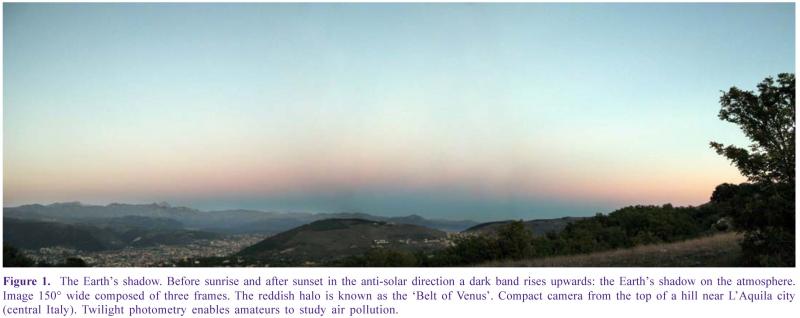Lunar eclipse brightness and the terrestrial atmosphere
2018 January 17

During a lunar eclipse, the solar rays arrive in the atmosphere and are refracted by the air. They then penetrate the shadow cone of the Earth (Figure 1) and impinge on the Moon’s surface. Hence, the Moon can still be seen even though it is totally immersed in the shadow cone (Figure 2).
The first rigorous theory of lunar eclipse brightness was proposed in 1933 by the Czech astronomer F. Link. Since then, a large amount of theoretical and experimental work has been conducted in order to provide an estimation of the lunar brightness during eclipses. Recently, several methods have been developed.
During a Lunar eclipse, the Earth’s atmosphere filters the sunlight. This filtering determines the brightness and colour of the eclipsed Moon. Therefore, it is reasonable to look at lunar eclipse photometry as a useful tool to investigate air transparency and atmospheric pollution.
In general, solar radiation undergoes three different processes, which may determine its attenuation. These processes are summarised as follows:
1 Refraction: Solar ray divergence by differential atmospheric refraction;
2 Absorption: Energy absorption by water vapour and aerosols in the troposphere and by ozone in the stratosphere;
3 Scattering: If the light impinges on atoms or molecules having a smaller dimension than the wavelength of light, scattering occurs according to a process called Rayleigh scattering or molecular scattering. This scattering is stronger for shorter wavelengths; it is rather isotropic and it explains the blue colour of the sky. Blue light is scattered five times more than red light (See Figure 3).
Particles of aerosols and water vapour in the air are generally much larger than the wavelength of light, but solar radiation is also scattered by aerosols and water. In this case, the process differs from molecular scattering and is called Mie scattering or aerosol scattering. For large particles the forward scattering becomes very important; the forward scattered radiation is about a thousand times the radiation scattered backward.
Rayleigh scattering dominates in the stratosphere, above an altitude of 10km. Mie scattering dominates in the troposphere, up to an altitude of almost 5km (Figure 3).
This work aims to quantify the concentration of molecular ozone (O3) in the stratosphere and the global pollution of the terrestrial atmosphere, by using the brightness values of total lunar eclipses.(continued…)
(Login or click above to view the full illustrated article in PDF format)
| The British Astronomical Association supports amateur astronomers around the UK and the rest of the world. Find out more about the BAA or join us. |
